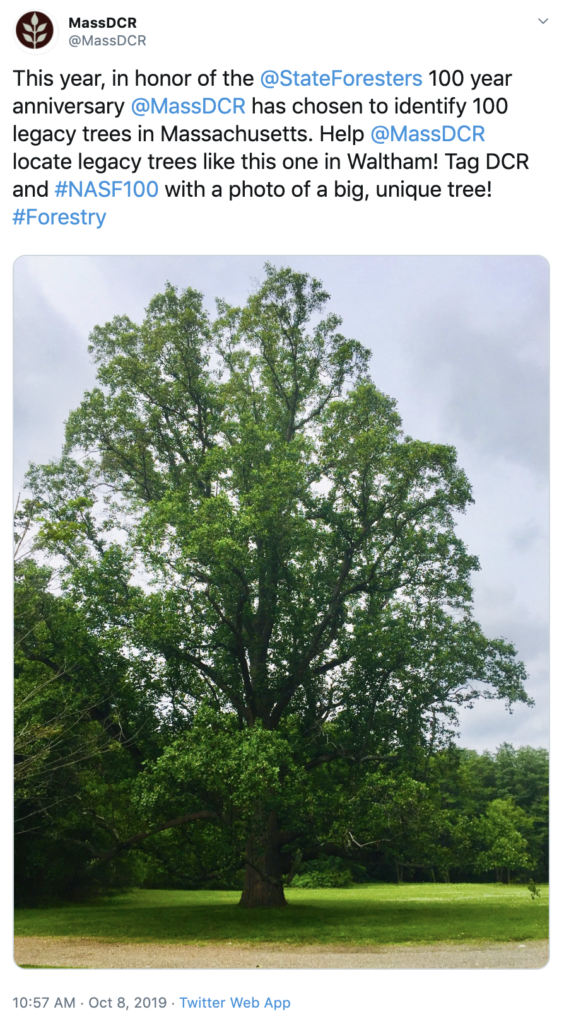By Rick Cantrell and Whitney Forman-Cook | This blog is a cross-post that appeared in the Winter 2020 edition of the National Woodlands Magazine.
The National Association of State Foresters is celebrating its 100th anniversary in 2020 with a Centennial Challenge campaign, honoring both the work of the association in providing a unified voice for state and private forestry since 1920, as well as the tremendous social, environmental, and economic contributions state forestry agencies have made over the last century.
State forestry agency employees work hand-in-hand with private landowners to manage and protect state and private forests, which encompass nearly two-thirds of forests nationwide. State forestry agencies are commemorating the last 100 years of public-private lands partnerships by planning, completing, and documenting unique 100-themed forestry events and initiatives, called Centennial Challenges.

The Centennial Celebration began in September at NASF’s 2019 Annual Meeting in Asheville, North Carolina, and will culminate at the 2020 NASF Annual Meeting in Pittsburgh, Pennsylvania. Already, several states have launched their challenges. Many of these Centennial Challenges are private lands-focused and many more rely on the participation of private landowners like you. Take Massachusetts’ for instance:
For their Centennial Challenge, the Massachusetts Department of Conservation and Recreation’s Forestry Department is asking its staff, partners, and Massachusetts residents to help identify 100 unique, significant, and otherwise noteworthy legacy trees on public and private land across the state.
A Massachusetts Legacy Tree can be any tree that is compelling for its age, size, form, history, species, and/or botanical interest. Head to www.stateforesters.org/news-events for more information on Massachusetts Centennial Challenge, as well as North Carolina’s and Washington state’s.
THE LAST 100 YEARS
Your state forestry agency provides the boots-on-the-ground for managing state forests and delivering forestry assistance to private owners. Across the country, state forestry agencies contribute significant non-federal, state resources to deliver a variety of programs and a multitude of services. Collectively, state forestry agencies:
- Directly employ 26,880 individuals, including 7,850 trained foresters and 12,280 wildland firefighters, who provide significant expertise, national capacity, and on-the-ground delivery of forestry and wildland fire management.
- Provide wildfire protection on 1.5 billion acres (including 1.1 billion acres in state and private ownership), that in 2018, cost them a total of $1.9 billion.
- Deliver state and federal fire department assistance programs, that in 2018, provided grants and equipment to 18,235 local fire departments and training to 57,810 local firefighters.
- Provide access to state and local fire and emergency response resources, which in 2018, included 93,656 firefighters, 91,940 fire engines, 2,851 dozers, and 620 aircraft.
- Serve as the primary source of forest management assistance for 56% (448 million acres) of the nation’s forestlands, which are privately owned.
- Actively manage 75 million acres of state-owned forests, spending over $450 million per year on average to achieve unparalleled health and resiliency.
- Provide upwards of 270,000 technical assists annually to forestland owners on topics ranging from forest management, tree health, and soil and water conservation, to prescribed fire use and wildlife habitat creation.
- Produce an average of 170 million tree seedlings a year for the restoration of native forest ecosystems.
- Protect drinking water sources originating on forestlands — which account for over 50% of the nation’s supply — through state forestry agency developed best management practices. State forestry agencies spend over 33 million dollars on water quality protection annually and consistently achieve a 90 percent BMP compliance rate or higher on average.
In 2017, state forestry agencies surpassed all their targets and treated 595,285 acres for invasive pests, 263,985 acres for native pests, and 80,985 acres for invasive plants for a combined total of 940,285 acres treated. And in 2018, state forestry agency expenditures totaled $3 billion. More than $2.4 billion of that (80 percent of their annual combined budget!) provided services to private landowners and local governments. This means that three out of every four dollars spent by state forestry agencies directly benefit lands not owned by the state.
One of the drivers of sustainable forest management on private lands is state forestry agency-prepared stewardship plans. In 2018, state forestry agencies developed 13,000 forest stewardship plans covering more than 10 million acres, the majority of which address areas designated as ‘high-priority’ in state Forest Action Plans. They also assisted 8,550 local governments with planning and caring for their communities’ tree canopies, which are also an important consideration addressed in Forest Action Plans.
As you well know, working forests are central to sustaining the economic, ecological, and social well-being of communities large and small, nationwide through the jobs they support and the benefits they provide. State-led Forest Stewardship Programs empower private landowners with the information they need to sustainably manage their forests. Forest Stewardship Plans encourage active and sustainable forest management that provides recreation, forest products, wildlife habitat, clean water and air, and renewable energy. State services also support a tremendous economic engine for the United States:
Nationwide, privately-owned forestland generates 2.4 million jobs, $98.7 billion in payroll, and $281 billion in timber sales and manufacturing shipments annually. In addition, privately-owned forestland contributes $81.3 billion, or 4.6 percent of the total manufacturing GDP.
LOOKING AHEAD TO THE NEXT 100
No one can predict what the next 100 years will look like, but you can bet state forestry agencies will be working to ensure the continued health and vitality of our greatest natural resource—America’s working forests.
Join us this year in celebrating our 100-year anniversary of working together to help conserve America’s state and private forests. Throughout the year-long campaign, we’ll be spotlighting state forestry agencies’ Centennial Challenges online. Help spread the word about your state agency’s good work by sharing or retweeting social media posts with the hashtags #CentennialChallenge and #NASF100, or by following our handle @stateforesters on Twitter, Facebook, and Instagram. Next quarter, we’ll have a Centennial Challenge update just for NWOA readers.
Have questions or comments? Contact Centennial Coordinator Rick Cantrell.

